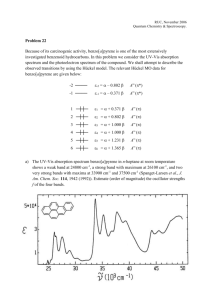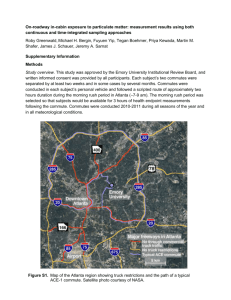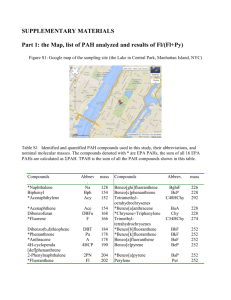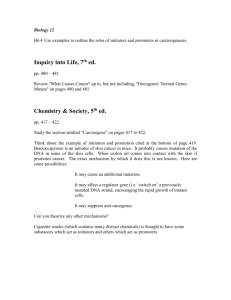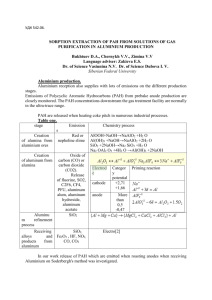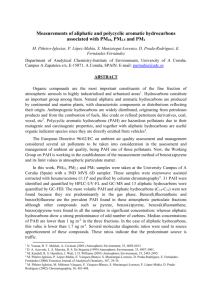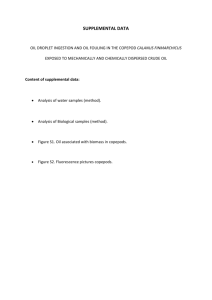Supplementary Information: Impact of natural gas
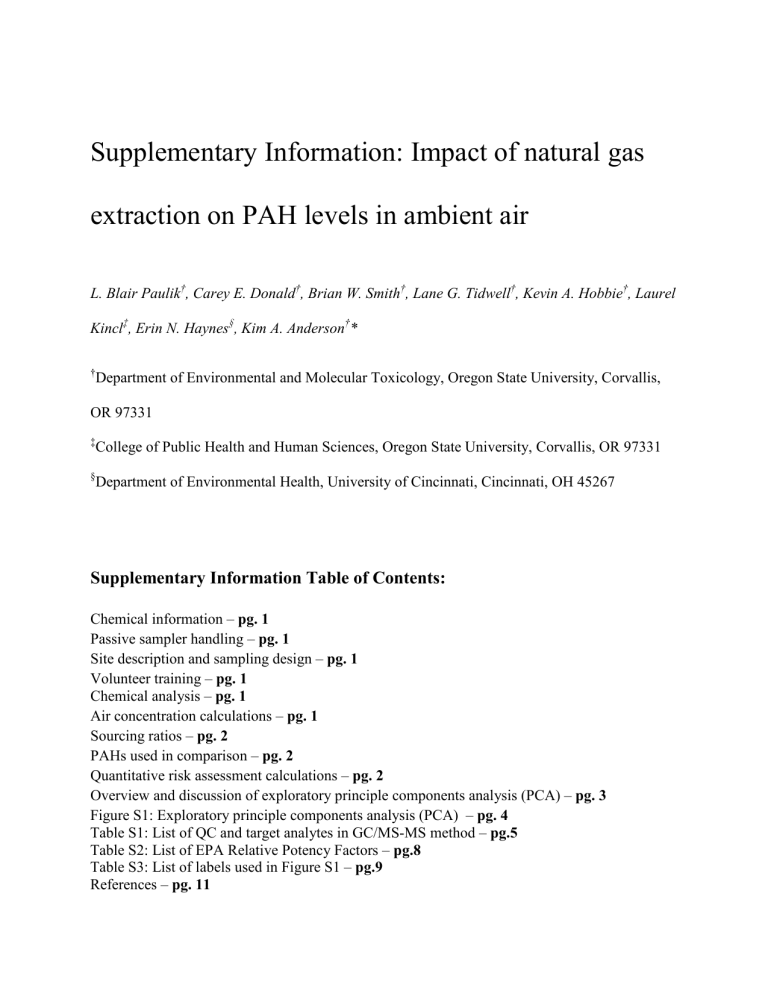
Supplementary Information: Impact of natural gas extraction on PAH levels in ambient air
L. Blair Paulik
†
, Carey E. Donald
†
, Brian W. Smith
†
, Lane G. Tidwell
†
, Kevin A. Hobbie
†
, Laurel
Kincl
‡
, Erin N. Haynes
§
, Kim A. Anderson
†
*
†
Department of Environmental and Molecular Toxicology, Oregon State University, Corvallis,
OR 97331
‡
College of Public Health and Human Sciences, Oregon State University, Corvallis, OR 97331
§
Department of Environmental Health, University of Cincinnati, Cincinnati, OH 45267
Supplementary Information Table of Contents:
Chemical information – pg. 1
Passive sampler handling – pg. 1
Site description and sampling design – pg. 1
Volunteer training – pg. 1
Chemical analysis – pg. 1
Air concentration calculations – pg. 1
Sourcing ratios – pg. 2
PAHs used in comparison – pg. 2
Quantitative risk assessment calculations – pg. 2
Overview and discussion of exploratory principle components analysis (PCA) – pg. 3
Figure S1: Exploratory principle components analysis (PCA) – pg. 4
Table S1: List of QC and target analytes in GC/MS-MS method – pg.5
Table S2: List of EPA Relative Potency Factors – pg.8
Table S3: List of labels used in Figure S1 – pg.9
References – pg. 11
1
Chemical information
Single PAH standards were purchased from Sigma Aldrich, in St. Louis, MO, Chiron, in
Trondheim, Norway, or Fluka (part of Sigma-Aldrich). PAH mixes were purchased from
Accustandard, in New Haven, CT. Labeled compounds used as performance reference compounds (PRCs), laboratory surrogates, or instrument internal standards were obtained from either CDN Isotopes, in Pointe-Claire, Quebec, Canada, Cambridge Isotope Laboratories, in
Tewksbury, MA, or Fisher Scientific in Pittsburgh, PA. All solvents were Optima-grade (from
Fisher Scientific, Pittsburgh, PA) or equivalent, and all laboratory glassware and other tools were baked at 450°C for 12 hours and/or solvent-rinsed before use. Water used to clean LDPE was filtered through a D7389 purifier purchased from Barnstead International, in Dubuque, IA.
Passive sampler handling
LDPE strips were cut from pre-sized polyethylene tubing that was approximately 2.7 cm wide. Each polyethylene strip was approximately 100 cm long and had a volume of 5.1 cm
3
.
LDPE was dried under filtered vacuum in stainless steel kegs, from AEB Kegs in Delebio, Italy.
TurboVap
®
evaporators were from Biotage, in Charlotte, NC.
Site description and sampling design
A significant fraction of the Carroll County’s residents earn their livings through farming.
Carroll County also sits on both the Marcellus and Utica Shales. It has therefore been part of the natural gas boom occurring in the United States in recent years. The exact number of days that samplers were deployed ranged from 18 to 28. Welch Fluorocarbon, Inc. is in Dover, NH.
Volunteer training
Volunteer landowners were trained in passive sampler handling, retrieval, and documentation by Oregon State University and University of Cincinnati community outreach specialists. Training included demonstration of retrieving samplers, practicing the technique, and time for discussion of questions and concerns. Volunteers were given handouts with step-by-step instructions of the sampler retrieval process. Handouts included a website with access to training videos, as well as contact information for OSU and UC trainers who would be available to answer questions.
Chemical analysis
Agilent is located in Alpharetta, GA. The temperature profile in the GC/MS-MS analytical method was as follows: 60°C for 1 minute, increasing 40°C per minute to reach
180°C, then increasing 3°C per minute to reach 230°C, then increasing 1.5°C per minute to reach
235°C, then increasing 15°C per minute to reach 280°C, staying at 280°C for 10 minutes, then increasing 6°C per minute to reach 298°C, and finally ramping up 16°C per minute to reach
350°C and stay there for 4 minutes. The dimensions of the Agilent Select PAH column were: 30 m, 0.25 mm, 0.15 µm. Continuing calibration standards were run nominally every 10 samples, and/or at the end of the sample set. If a closing standard did not meet the criteria, samples were re-run after the standard was verified.
Air concentration calculations
Vapor phase air concentrations were determined using an empirical uptake model.
Sampling rates were derived by measuring PRC loss, as described in Huckins et al
2 allow for an accurate assessment of in situ uptake rates for a wide range of analytes in variable
. The uptake calculation does not make any assumptions about the
analyte being at equilibrium, so this model was used for air concentration calculations for all
PAHs. PRCs share similar physical and chemical properties with the target PAHs in this study and spanned a range of log K oa
a
) of PAHs were determined using equation S1:
Eq. S1
C a
=
V s
K sa
N analyte
(1−exp�−
Rst
VsKsa
�)
In equation S1, C a
is the air concentration, N analyte is the mass of the compound of interest present in the sampler, V s is the sampler volume, K sa
is the sampler-air partition coefficient, R s is the compound specific sampling rate, and t is the duration of sampling. An analyte-specific K sa was calculated for each target PAH and PRC using a regression based on individual octanol-air partition coefficients (K oa
). Sampling rates (R s
) of the PRCs were determined using equation S2:
Eq. S2
R s
= − ln( t
N
N0
)
K sa
V s
In equations S2 and S3, N
0
and N are the mass of PRC present at the beginning and ending of the sampling period, respectively. The sampling rate (R s
) for each analyte was calculated based on the R s of the PRC with the most similar K oa
. Eq S3 uses compound class-specific modifiers (a) to compensate for compound-specific adjustments between the PRC and the target analyte.
Eq. S3
R s,target analyte
= R s,PRC
∗ 𝛂 analyte 𝛂
PRC
Sourcing ratios
Petrogenic PAH sources are typically enriched in the more thermodynamically stable
. In the two isomer pairs of PAHs used for PAH sourcing, phenanthrene and pyrene are
the more thermodynamically stable isomers. Thus, a higher phenanthrene/anthracene, and a lower fluoranthene/pyrene ratio each indicate that the sample is predominantly petrogenic. A few samples had slightly pyrogenic signatures according to one ratio. However, more than one ratio should be used to confirm PAH source, as interpretation of values near the boundaries between
PAHs used in comparison
The 14 PAHs used in the comparison in Figure 2 were were Acenaphthylene, acenaphthene, fluorene, phenanthrene, anthracene, fluoranthene, pyrene, benzo[a]anthracene, chrysene, benzo[b]fluoranthene, benzo[k]fluoranthene, benzo[a]pyrene, benzo[g,h,i]perylene, and indeno[1,2,3-cd]pyrene. PAHs measured during the same season as the present study were used in this comparison where possible.
Quantitative risk assessment calculations
There were 10 PAHs that were above the detection limits and had nonzero RPFs (see
Table S2). Thus, these were the 10 PAHs that were used in the carcinogenic risk assessment.
These 10 PAHs were benzo[a]pyrene, benzo[b]fluoranthene, cyclopenta[c,d]pyrene, benzo[j]fluoranthene, benzo[a]anthracene, chrysene, fluoranthene, indeno[1,2,3-c,d]pyrene, benzo[k]fluoranthene, and benzo[g,h,i]perylene.
3
Risk assessment was performed using equations from the EPA’s 2009 Risk Assessment
Eq. S4
EC =
(CA x ET x EF x ED)
AT
In equation S4, EC is the exposure concentration in ng/m
3
, CA is the contaminant concentration in air in ng/m
3
, ET is the exposure time in hours/day, EF is the exposure frequency in days/year,
ED is the exposure duration in years, and AT is the averaging time. The AT includes the lifetime in years multiplied by 365 days/year and 24 hours/day.
Eq. S5 ELCR = IUR x EC
In equation S5, ELCR is excess lifetime cancer risk, IUR is inhalation unit risk, and EC is the exposure concentration from Equation S4. In this study, an IUR of 8.7 × 10
-5 ng/m3 was used.
This is an IUR that was estimated for benzo[a]pyrene by the World Health Organization
was used because the U.S. EPA has no established an IUR for PAHs.
Overview and discussion of exploratory principle components analysis (PCA)
Exploratory data analysis was performed using a Principle Component Analysis (PCA) biplot showing scores and loadings plots together. All PAH variables that were above detection limits were used, in addition to the distance to closest well variable. Only sites previously classified as close or far were included. The data were first square root transformed and then mean centered and scaled. PC1 and PC3 were chosen as graph axes because the resulting PCA graph displayed good delineation between close and far sites and suggested which variables contributed most to this ‘clumping’. PCA was performed using Primer-E version 6.1.13. A list of labels used in the PCA plot and the PAHs they correspond to can be found in Table S3.
Figure S1 shows that pyrene (p26) has the closest negative correlation with distance to the nearest active NGE well. This reinforces the results of the sourcing ratios in Figure 3. Given that pyrene is one of the PAHs used to indicate petrogenic signatures in the sourcing ratios, it is interesting that this is one of the main PAHs explaining the PAH data through PCA.
Figure S1 also shows samples in the close and far groups clumping separately. Looking closer at the clustering in the plot is also interesting. Samples in the far group are broken into two clusters of three samples. Far samples 1-3 cluster closer to the close samples, while far samples
4-6 cluster farther away from the rest of the samples. Interestingly, in the cluster that is closer to the close samples, two were located within 0.05 miles of heavily trafficked roads. This could potentially be a confounding factor.
4
Figure S1. Exploratory principle components analysis (PCA) using PAHs and distance to closest active NGE well treated as covariates. The graph only includes data for samples in the close
(n=5) and far (n=6) distance groups.
5
Table S1 : List of performance reference compounds (PRCs), internal standard (IS), surrogates, and target polycyclic aromatic hydrocarbons (PAH) in the GC/MS Triple Quad method used for
PAH analysis in this study, with limits of detection (LOD) and limits of quantification (LOQ).
PAH
Target, IS,
PRC, or
Surrogate?
CAS #
LOD
(ng/mL)
LOQ
(ng/mL)
Fluorene-d10 PRC 81103-79-9 .33 1
Pyrene-d10 PRC 1718-52-1 0.42 2.09
Benzo[b]fluoranthene-d12 PRC 205-99-2 1.67 5
Perylene-d12 IS 1520-96-3 1.67
Naphthalene-d8 Surrogate 1146-65-2 .33 1
Acenaphthylene-d8 Surrogate 93951-97-4 .33 1
Phenanthrene-d10 Surrogate 1517-22-2 1.67 5
Fluoranthene-d10 Surrogate 93951-69-0 1.67 5
Chrysene-d12 Surrogate 1719-03-5 1.67 5
Benzo[a]pyrene-d12 Surrogate 63466-71-7 1.67 5
Benzo[ghi]perylene-d12 Surrogate 93951-66-7 1.67 5
Naphthalene Target 91-20-3 1.04 5.20
2-Methylnaphthalene Target 91-57-6 0.70 3.50
1-Methylnaphthalene Target 90-12-0 0.28 1.39
2-Ethylnaphthalene Target 939-27-5 0.97 4.84
2,6-Dimethylnaphthalene Target 581-42-0 0.89 4.43
1,6-Dimethylnaphthalene Target 575-43-9 0.81 4.05
1,4-Dimethylnaphthalene Target 571-58-4 1.24 6.22
1,5-Dimethylnaphthalene Target 571-61-9 1.19 5.93
1,2-Dimethylnaphthalene Target 573-98-8 .94 4.70
1,8-Dimethylnaphthalene Target 569-41-5 0.83 4.15
2,6-Diethylnaphthalene Target 59919-41-4 0.81 4.06
Acenaphthylene Target 208-96-8 2.33 11.65
Acenaphthene Target 83-32-9 1.07 5.35
Fluorene Target 86-73-7 0.79 3.97
Dibenzothiophene Target 132-65-0 0.24 1.20
Phenanthrene Target 85-01-8 0.46 2.31
Anthracene Target 120-12-7 1.05 5.23
2-Methylphenanthrene Target 2531-84-2 0.39 1.93
2-Methylanthracene Target 613-12-7 0.47 2.36
1-Methylphenanthrene Target 832-69-9 1.06 5.32
9-Methylanthracene
3,6-Dimethylphenanthrene
2,3-Dimethylanthracene
Fluoranthene
9,10-Dimethylanthracene
Pyrene
Retene
Benzo[a]fluorene
Benzo[b]fluorene
Benzo[c]fluorene
1-Methylpyrene
Benz[a]anthracene
Cyclopenta[c,d]pyrene
Triphenylene
Chrysene
6-Methylchrysene
5-Methylchrysene
Benzo[b]fluoranthene
7,12-Dimethylbenz[a]anthracene
Benzo[k]fluoranthene
Benzo[j]fluoranthene
Benz[j]&[e]aceanthrylene
Benzo[e]pyrene
Benzo[a]pyrene
Indeno(1,2,3-c,d)pyrene
Dibenzo[a,h]pyrene
Picene
Benzo[ghi]perylene
Anthanthrene
Naphtho[1,2-b]fluoranthene
Naphtho[2,3-j]fluoranthene
Dibenzo[a,e]fluoranthene
Dibenzo[a,l]pyrene
Naphtho[2,3-k]fluoranthene
Naphtho[2,3-e]pyrene
Target
Target
Target
Target
Target
Target
Target
Target
Target
Target
Target
Target
Target
Target
Target
Target
Target
Target
Target
Target
Target
Target
Target
Target
Target
Target
Target
Target
Target
Target
Target
Target
Target
Target
Target
1.67
0.30
0.38
0.75
0.53
0.41
0.50
0.89
0.87
0.42
0.34
0.54
0.85
0.42
0.84
1.67
1.67
0.37
0.94
0.53
0.56
1.67
0.71
1.18
0.26
1.02
0.74
0.34
0.33
1.67
1.67
0.47
0.48
1.67
1.67
3697-24-3
205-99-2
57-97-6
207-08-9
205-82-3
202-33-5 and
199-54-2
192-97-2
50-32-8
193-39-5
53-70-3
213-46-7
191-24-2
191-26-4
5385-22-8
205-83-4
5385-75-1
191-30-0
207-18-1
193-09-9
779-02-2
1576-67-6
613-06-9
206-44-0
781-43-1
129-00-0
483-65-8
238-84-6
243-17-4
205-12-9
2381-21-7
56-55-3
27208-37-3
217-59-4
218-01-9
1705-85-7
5
1.50
1.90
3.77
2.67
2.04
2.49
4.44
4.37
2.08
1.71
2.72
4.23
2.09
4.19
5
5
1.85
4.71
2.63
2.79
5
3.53
5.90
1.32
5.11
3.72
1.71
1.65
5
5
2.36
2.41
5
5
6
Dibenzo[a,e]pyrene
Coronene
Dibenzo[e,l]pyrene
Naphtho[2,3-a]pyrene
Benzo[b]perylene
Dibenzo[a,i]pyrene
Dibenz[a,h]anthracene
Target
Target
Target
Target
Target
Target
Target
192-65-4
191-07-1
192-51-8
196-42-9
197-70-6
189-55-9
189-64-0
6.44
0.70
1.67
1.67
1.67
1.42
0.52
7
32.22
3.49
5
5
5
7.10
2.60
Table S2: “PAHs with final RPFs based on tumor bioassay data,” from the U.S. EPA’s 2010
Development of a Relative Potency Factor (RPF) Approach for Polycyclic Aromatic
PAH
Anthanthrene
Anthracene
Relative Potency Factor
0.4
0
Benz[a]anthracene
Benz[b,c]aceanthrylene
Benzo[b]fluoranthene
Benzo[c]fluorene
0.2
0.05
0.8
20
Benz[e]aceanthrylene
Benzo[g,h,i]perylene
Benz[j]aceanthrylene
Benzo[j]fluoranthene
Benzo[k]fluoranthene
Benz[l]aceanthrylene
Chrysene
Cyclopenta[c,d]pyrene
Cyclopenta[d,e,f]chrysene
Dibenzo[a,e]fluoranthene
Dibenzo[a,e]pyrene
0.8
0.009
60
0.3
0.03
5
0.1
0.4
0.3
0.9
0.4
Dibenz[a,h]anthracene 10
Dibenzo[a,h]pyrene
Dibenzo[a,i]pyrene
Dibenzo[a,l]pyrene
Fluoranthene
Indeno[1,2,3-c,d]pyrene
0.9
0.6
30
0.08
0.07
Naphtho[2,3-e]pyrene 0.3
Phenanthrene
Pyrene
Benzo(a)pyrene
0
0
1
8
9 p31 p32 p33 p34 p35 p36 p37 p38 p39 p40 p41 p23 p24 p25 p26 p27 p28 p29 p30 p15 p16 p17 p18 p19 p20 p21 p22 p7 p8 p9 p10 p11 p12 p13 p14 p3 p4 p5 p6
Table S3 : A list of labels used in the PCA plot in Figure S1, and the corresponding PAH names.
PCA Label PAH p1 p2
Naphthalene
2-Methylnaphthalene
1-Methylnaphthalene
2-Ethylnaphthalene
2,6-Dimethylnaphthalene
1,6-dimethylNaphthalene
1,4-dimethylnaphthalene
1,5-dimethylnaphthalene
1,2-dimethylnaphthalene
1,8-Dimethylnaphthalene
2,6-Diethylnaphthalene
Acenaphthylene
Acenaphthene
Fluorene
Dibenzothiophene
Phenanthrene
Anthracene
2-Methylphenanthrene
2-Methylanthracene
1-Methylphenanthrene
9-Methylanthracene
3,6-Dimethylphenanthrene
Fluoranthene
2,3-Dimethylanthracene
9,10-Dimethylanthracene
Pyrene
Retene
Benzo[a]fluorene
Benzo[b]fluorene
Benzo[c]fluorene
1-Methylpyrene
Benzo[a]anthracene
Cyclopenta[cd]pyrene
Triphenylene
Chrysene
6-Methyl chrysene
5-Methylchrysene
Benzo [b] fluoranthene
7,12-Dimethylbenz[a]anthracene
Benzo [k] fluoranthene
Benzo [j] fluoranthene
p50 p51 p52 p53 p54 p55 p56 p57 p42 p43 p44 p45 p46 p47 p48 p49 p58 p59 p60 p61
Benzo [e] pyrene
Benzo [a] pyrene
Indeno [1,2,3-c,d] pyrene
Dibenzo [a,h] anthracene
Benzo [a] chrysene
Benzo [g,h,i] perylene
Anthanthrene
Naphtho[1,2-b]fluoranthene
Naphtho[2,3-j]fluoranthene
Dibenzo [a,e] flouranthene
Dibenzo [a,l] pyrene
Naphtho[2,3-k]fluoranthrene
Naphtho[2,3-e]pyrene
Dibenzo [a,e] pyrene
Coronene
Dibenzo[e,l]pyrene
Naphtho[2,3-a]pyrene
Benzo [b] perylene
Dibenzo [a,i] pyrene
Dibenzo [a,h] pyrene
10
11
References
1.
Environment Springer: New York, 2006.
Huckins, J. N., Petty, Jimmie D., Booij, Kees. , Monitors of Organic Chemicals in the
2. Bartkow, M. E.; Jones, K. C.; Kennedy, K. E.; Holling, N.; Hawker, D. W.; Müller, J. F.,
Evaluation of performance reference compounds in polyethylene-based passive air samplers.
Environ. Pollut. 2006, 144 , (2), 365-370.
3. Huckins, J. N.; Petty, J. D.; Lebo, J. A.; Almeida, F. V.; Booij, K.; Alvarez, D. A.;
Cranor, W. L.; Clark, R. C.; Mogensen, B. B., Development of the permeability/performance reference compound approach for in situ calibration of semipermeable membrane devices.
Environmental Science & Technology 2002, 36 , (1), 85-91.
4. Söderström, H. S.; Bergqvist, P.-A., Passive air sampling using semipermeable membrane devices at different wind-speeds in situ calibrated by performance reference compounds. Environmental Science & Technology 2004, 38 , (18), 4828-4834.
5. Budzinski, H.; Jones, I.; Bellocq, J.; Pierard, C.; Garrigues, P., Evaluation of sediment contamination by polycyclic aromatic hydrocarbons in the Gironde estuary. Mar. Chem. 1997,
58 , (1), 85-97.
6. Yunker, M. B.; Macdonald, R. W.; Vingarzan, R.; Mitchell, R. H.; Goyette, D.;
Sylvestre, S., PAHs in the Fraser River basin: a critical appraisal of PAH ratios as indicators of
PAH source and composition. Org. Geochem. 2002, 33 , (4), 489-515.
7. EPA, U. S. Risk Assessment Guidance for Superfund Office of Superfund Remediation and Technology Innovation: Washington, D.C., 2009.
8. WHO Air quality guidelines for Europe ; World Health Organization Regional Office for
Europe: Copenhagen, Denmark, 2000.
9. EPA, U. S. Development of a Relative Potency Factor (RPF) Approach for Polycyclic
Aromatic Hydrocarbon (PAH) Mixtures. ; Intregrated Risk Information Systems (IRIS):
Washington, D.C., 2010.
